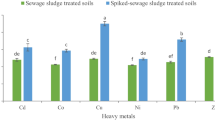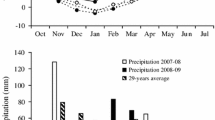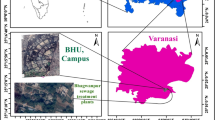Abstract
A greenhouse experiment was performed to assess the soil heavy metal pools, growth, yield, and heavy metal uptake of wheat plants (Triticum aestivum L.) that are grown at different rates in soils supplemented with sewage sludge (SS). The experimental design was completely randomized, with six replicates per treatment. The application of SS significantly increased the soil organic matter content. Generally, most growth parameters, as well as the biomass of treated wheat, were significantly increased with the amendment of SS, up to the addition rate of 40 g kg−1. The content of all heavy metals (except Cr in grains and Pb in spikes) significantly increased in different tissues of treated wheat with the increasing rate of SS application. However, all heavy metal concentrations (except for Al, Cr, Fe, and Mn in the roots) were normal and did not overcome the phytotoxic levels. The wheat was recognized by a bioaccumulation factor < 1.0 for most of the heavy metals. The translocation factor for all of the heavy metals was < 1.0. Therefore, the SS utilized in the present study could be used as a valuable organic fertilizer in wheat cultivation areas in Saudi Arabia and could also act as an eco-friendly method for the recycling of SS.


Similar content being viewed by others
References
Allen S (1989) Chemical analysis of ecological materials. Blackwell Scientific Publications, London
Antoniadis V, Koutroubas SD, Fotiadis S (2015) Nitrogen, phosphorus, and potassium availability in manure- and sewage sludge-applied soil. Commun Soil Sci Plant Anal 46:393–404
Baker AJM (1981) Accumulators and excluders—strategies in the response of plants to heavy metals. J Plant Nutr 3:643–654
Bose S, Bhattacharyya AK (2008) Heavy metal accumulation in wheat plant grown in soil amended with industrial sludge. Chemosphere 70:1264–1272
Boudjabi S, Kribaa M, Chenchouni H (2015) Growth, physiology and yield of durum wheat (Triticum durum) treated with sewage sludge under water stress conditions. EXCLI J 14:320–334
Bouzerzour H, Tamrabet L, Kribba M (2002) Response of barley and oat to the wastewater irrigation and to the sludge treatment. Proc Int Seminar: Biol Environ University of Mentouri, Consantine, p 71
Brown S, Leonard P (2004) Recycling of organic carbon in organic wastes is also important for C sequestration in soils. BioCycle 2004:25–29
Brunetti G, Farrag K, Rovira PS, Nigro F, Sensi N (2011) Greenhouse and field studies on Cr, Cu, Pb and Zn phytoextraction by Brassica napus from contaminated soils in the Apulia region, Southern Italy. Geoderma 160:517–523
Chandra R, Yadav S, Mohan D (2008) Effect of distillery sludge on seed germination and growth parameters of green gram (Phaseolus mungo L.). J Hazard Mater 152:431–439
Codex Alimentarious Commission (2011) Contaminants in foods, joint FAO/WHO food standards program (fifth session). Codex Alimentarius, The Hague
Council of the European Communities (2001) Waste management (use of sewage sludge in agriculture) (amendment) regulations. SIS:267
Dai L, Peng B, Wei B, Ma G (2014) Effects of land application of municipal sewage sludge on growth, physiology and accumulation of heavy metals in wheat (Triticum aestivum L.). Adv Mater Res 878:647–656
De Vita P, Di Paolo E, Fecondo G, Di Fonzo N, Pisante M (2007) No-tillage and conventional tillage effects on durum wheat yield, grain quality and soil moisture content in southern Italy. Soil Till Res 92:69–78
Debiase G, Montemurro F, Fiore A, Rotolo C, Farrag K, Miccolis A, Brunetti G (2016) Organic amendment and minimum tillage in winter wheat grown in Mediterranean conditions: effects on yield performance, soil fertility and environmental impact. Eur J Agron 75:149–157
Eid EM, Shaltout KH (2014) Monthly variations of trace elements accumulation and distribution in above- and below-ground biomass of Phragmites australis (Cav.) Trin. Ex Steudel in Lake Burullus (Egypt): a biomonitoring application. Ecol Eng 73:17–25
Eid EM, Shaltout KH (2016) Bioaccumulation and translocation of heavy metals by nine native plant species grown at a sewage sludge dump site. Int J Phytoremed 18:1075–1085
Eid EM, El-Bebany AF, Alrumman SA, Hesham A, Taher MA, Fawy KF (2017a) Effects of different sewage sludge applications on heavy metal accumulation, growth and yield of spinach (Spinacia oleracea L.). Int J Phytoremed 19:340–347
Eid EM, Alrumman SA, El-Bebany AF, Hesham A, Taher MA, Fawy KF (2017b) The effects of different sewage sludge amendment rates on the heavy metal bioaccumulation, growth and biomass of cucumbers (Cucumis sativus L.). Environ Sci Pollut Res 24:16371–16382
Eid EM, Alrumman SA, El-Bebany AF, Fawy KF, Taher MA, Hesham A, El-Shaboury GA, Ahmed MT (2018) The evaluation of sewage sludge application as a fertilizer for broad bean (Faba sativa Bernh.) crops. Food Energy Secur 7:e00142
FAOSTAT (2017) Crops. http://www.fao.org/faostat/en/#data/QC. Accessed 02 Nov 2017
Förstner U (1991) Soil pollution phenomena—mobility of heavy metal in contaminated soil. In: Bolt GH, De Boodt MF, Hayes MHB, McBride MB (eds) Interaction at the soil colloid–soil solution interface. Kluwer Academic Publishers, Dordrecht, pp 543–582
Frost HL, Ketchum LH (2000) Trace metal concentration in durum wheat from application of sewage sludge and commercial fertilizer. Adv Environ Res 4:347–355
Ghosh M, Singh SP (2005) A review on phytoremediation of heavy metals and utilization of its byproducts. Appl Ecol Environ Res 3:1–18
Kabata-Pendias A (2011) Trace elements in soils and plants. In: CRC Press. Florida, Boca Raton
Khan RA, Hussein M, Khan AR, Khan S (2015) Preliminary soil properties analysis of Abha City, Saudi Arabia: a case study. Int Res J Emerg Trend Multidiscip 1:1–6
Kim IS, Kang KH, Johnson-Green P, Lee EJ (2003) Investigation of heavy metal accumulation in Polygonum thunbergii for phytoextraction. Environ Pollut 126:235–243
Kirchmann H, Pilchmayer F, Gerzabek KH (1996) Sulfur balance and sulphur-34 abundance in a long term fertilizer experiment. Soil Sci Soc Am J 60:174–178
Kominko H, Gorazda K, Wzorek Z (2017) The possibility of organo-mineral fertilizer production from sewage sludge. Waste Biomass Valor 8:1781–1791
Koutroubas SD, Antoniadis V, Fotiadis S, Damalas CA (2014) Growth, grain yield and nitrogen use efficiency of Mediterranean wheat in soils amended with municipal sewage sludge. Nutr Cycl Agroecosyst 100:227–243
Kumar V, Chopra AK (2012) Fertigation effect of distillery effluent on agronomical practices of Trigonella foenum-graecum L. (fenugreek). Environ Monit Assess 184:1207–1219
Kumar V, Chopra AK (2014) Accumulation and translocation of metals in soil and different parts of French bean (Phaseolus vulgaris L.) amended with sewage sludge. Bull Environ Contam Toxicol 92:103–108
Kummer ACB, Filho HG, Lobo TF, Lima RADS (2016) Composted sewage sludge in replacement of mineral fertilization on wheat production and development. J Braz Assoc Agric Eng 36:706–714
Latare AM, Kumar O, Singh SK, Gupta A (2014) Direct and residual effect of sewage sludge on yield, heavy metals content and soil fertility under rice–wheat system. Ecol Eng 69:17–24
Liu Z, Yang Y, Bai Y, Huang Y, Nan Z, Zhao C, Ma J, Wang H (2016) The effect of municipal sludge compost on the mobility and bioavailability of Cd in a sierozem–wheat system in an arid region northwest of China. Environ Sci Pollut Res 23:20232–20242
Mahdy AM, Elkhatib EA, Fathi NO (2007) Cadmium, copper, nickel, and lead availability in biosolids-amended alkaline soils. Aust J Basic Appl Sci 1:354–363
McBride MB (1994) Environmental chemistry of soils. Oxford University Press, Oxford
Mishra RN, Behera PK (1991) The effect of paper industry effluent on growth pigment, carbohydrate, and protein of rice seedlings. Environ Pollut 72:159–168
Radford PJ (1967) Growth analysis formulae—their use and abuse. Crop Sci 7:171–175
Rato Nunes J, Cabral F, López-Piñeiro A (2008) Short-term effects on soil properties and wheat production from secondary paper sludge application on two Mediterranean agricultural soils. Bioresour Technol 99:4935–4942
Samara E, Matsi T, Balidakis A (2017) Soil application of sewage sludge stabilized with steelmaking slag and its effect on soil properties and wheat growth. Waste Manag 68:378–387
Samaras V, Tsadilas CD, Stamatiadis S (2008) Effects of repeated application of municipal sewage sludge on soil fertility, cotton yield, and nitrate leaching. Agron J 100:477–483
Singh RP, Agrawal M (2007) Effects of sewage sludge amendment on heavy metal accumulation and consequent responses of Beta vulgaris plants. Chemosphere 67:2229–2240
Singh RP, Agrawal M (2008) Potential benefits and risks of land application of sewage sludge. Waste Manag 28:347–358
Statsoft (2007) Statistica version 7.1. Statsoft Inc, Tulsa, Oklahoma
Tamrabet L, Bouzerzour H, Kribaa M, Makhlouf M (2008) Response of durum wheat (Triticum durum Desf) cultivar Acsad 1107 to sewage sludge amendment under a semi-arid climate. In: Baz IA, Otterpohl R, Wendland C (eds) Efficient management of wastewater. Springer-Verlag, Berlin Heidelberg, pp 103–111
Tsadilas C, Samaras V, Evangelou E, Shaheen SM (2014) Influence of fly ash and sewage sludge application on wheat biomass production, nutrients availability, and soil properties. Int J Coal Sci Technol 1:221–226
Vieira RF, Moriconi W, Pazianotto RAA (2014) Residual and cumulative effects of soil application of sewage sludge on corn productivity. Environ Sci Pollut Res 21:6472–6481
Wang X, Chen T, Ge Y, Jia Y (2008) Studies on land application of sewage sludge and its limiting factors. J Hazard Mater 160:554–558
Wei Y, Liu Y (2005) Effects of sewage sludge compost application on crops and cropland in a 3-year field study. Chemosphere 59:1257–1265
Wilke BM (2005) Determination of chemical and physical soil properties. In: Margesin R, Schinner F (eds) Manual for soil analysis—monitoring and assessing soil bioremediation. Springer-Verlag, Heidelberg, pp 47–95
Yilmaz DD, Temizgül A (2014) Determination of heavy-metal concentration with chlorophyll contents of wheat (Triticum aestivum) exposed to municipal sewage sludge doses. Commun Soil Sci Plant 45:2754–2766
Acknowledgements
This work was supported by the Deanship of Scientific Research at King Khalid University (Project Number R.G.P. 1/14/38).
Author information
Authors and Affiliations
Corresponding author
Additional information
Responsible editor: Philippe Garrigues
Rights and permissions
About this article
Cite this article
Eid, E.M., Alrumman, S.A., El-Bebany, A.F. et al. Evaluation of the potential of sewage sludge as a valuable fertilizer for wheat (Triticum aestivum L.) crops. Environ Sci Pollut Res 26, 392–401 (2019). https://doi.org/10.1007/s11356-018-3617-3
Received:
Accepted:
Published:
Issue Date:
DOI: https://doi.org/10.1007/s11356-018-3617-3




